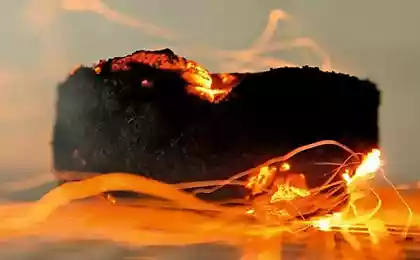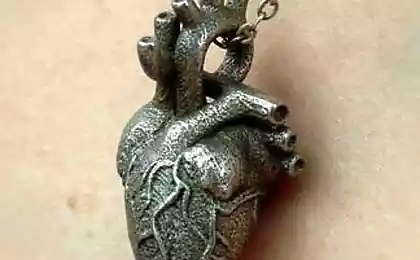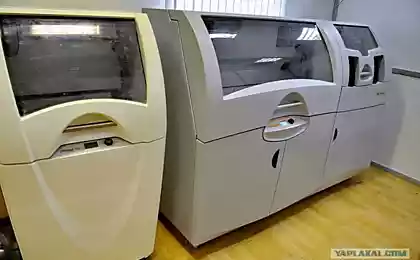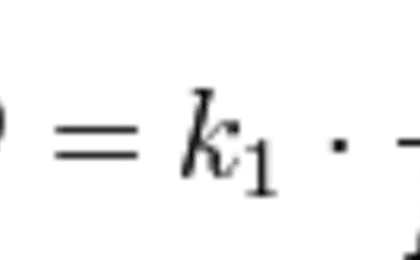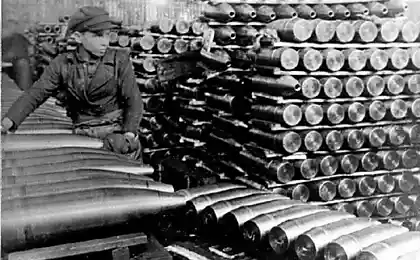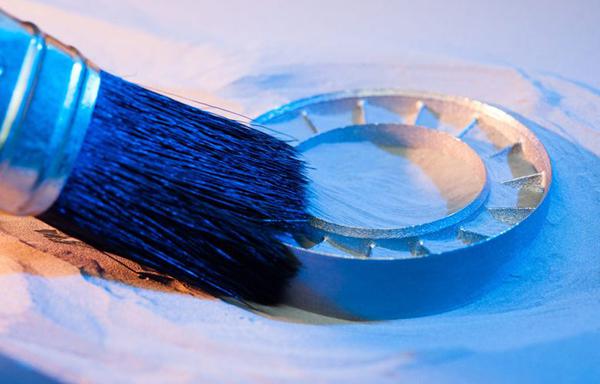
In this review, I tried to lead a popular form of basic information about the production of metal products by laser additive manufacturing - a relatively new and interesting technological methods that emerged in the late 80's and has become nowadays a promising technology for small-batch or unit of production in the field of medicine, the plane - and rocketry.
Briefly describe the principle of operation of the plant for production of the additive by means of laser radiation can be as follows. Apparatus for applying and leveling the powder layer removes a layer powder feeder and distributes it evenly over the surface of the substrate. Then the laser beam scans the surface of the layer of powder by melting or sintering product forms. After scanning the powder layer platform with manufactured products falls on the layer thickness, and the platform is raised with the powder, and the process of applying a layer of powder and the scan is repeated. After completion of the platform is raised and the product is purified from the unused powder.
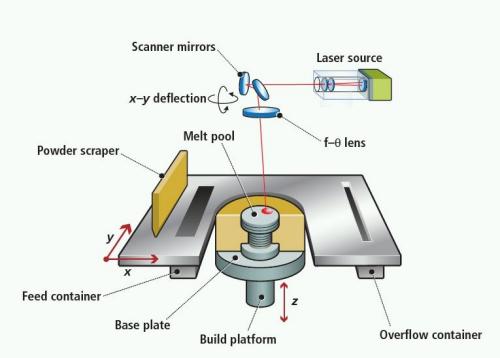
One of the main parts of an additive in the production plants is a laser system that uses CO
2 sub>, Nd: YAG, Yb fiber or disk laser. Found that the use of lasers with a wavelength of 1.1, 1 micron for heating metal and carbides preferable because they are 25-65% better absorb laser-generated radiation. At the same time, the use of CO 2 sub> laser with a wavelength of 10 microns 64 most best suited for materials such as polymers and oxide ceramics. Higher absorption capacity increases the penetration depth and in a wider range varying process parameters. Usually lasers used in additive manufacturing, work in continuous mode. In comparison, the use of lasers operating in the pulsed mode and Q-switched due to their high energy pulse and short pulse duration (nanosecond) gives the opportunity to improve the bond strength between the layers and reduce the heat affected zone. It can be concluded that the characteristics of laser systems are used in such a range, the laser power - 50-500 W, the scanning speed of 2 m / s, positioning speed to 7 m / s, the diameter of the focused spots - 35-400 microns.
In addition to the laser as a source of heating of the powder can be used electron-beam heating. This version company Arcam is proposed and implemented in their facilities in 1997 with the installation of electron-beam gun is characterized by the absence of moving parts, as the electron beam is focused and guided by the magnetic field and the baffles, and the creation of a vacuum in the chamber has a positive effect on the quality of the products.
One of the important conditions for additive manufacturing is the creation of a protective environment prevents oxidation of the powder. To fulfill this condition using argon or nitrogen. However, the use of nitrogen as protective gas is limited, which is connected so as to form nitrides (e.g., AlN, TiN in the manufacture of articles made of aluminum and titanium alloys), which lead to a decrease in material ductility.
Methods of laser additive manufacturing process on the specifics of the seal material can be divided into selective laser sintering (Selective Laser Sintering (SLS)), indirect metal laser sintering (Indirect Laser Metal Sintering (ILMS)), direct metal laser sintering (Direct Laser Metal Sintering (DLMS) ) and selective laser melting (Selective Laser Melting (SLM)). In the first embodiment, the seal layer of the powder takes place by solid-phase sintering. In the second - by impregnating a bundle of porous frame previously formed by laser irradiation. At the heart of a direct metal laser sintering is a seal mechanism of liquid phase sintering due to the melting of low-melting component of the powder mixture. In the latter embodiment, the seal is due to complete melting and melt flow. It is worth noting that the classification is not universal, since one type of additive manufacturing process may occur seal mechanisms that are common to other processes. For example, when DLMS and SLM may be a solid-phase sintering, which occurs when SLS, whereas in SLM may be a liquid-phase sintering which is more typical for the DLMS.
selective laser sintering (SLS) h4>
Solid-phase selective laser sintering is not widespread as to better flow of the bulk and surface diffusion, viscous flow and other processes that occur during sintering of powder requires a relatively long exposure to laser radiation. This leads to long-term operation of the laser and the low productivity of the process, making the process economically feasible. In addition, there are difficulties with maintaining the process temperature in the range between the melting point and sintering temperature of the solid. The advantage of the solid-phase selective laser sintering is possible to use a wider range of materials for the manufacture of products.
Indirect metal laser sintering (ILMS) h4>
The process, called "indirect laser sintering of metals" was developed by DTMcorp of Austin in 1995, which since 2001 is owned by 3D Systems. In ILMS process using a mixture of powder and polymer powder or polymer coated, where the polymer acts as a binder and provide the necessary strength for further thermal treatment. At the stage of the heat treatment is carried out stripping polymer sintering frame and impregnation of porous metal-bonded frame, that results in a finished product.
For ILMS powders can be used as metals and ceramics, or mixtures thereof. Preparation of the mixture with the polymer powder is carried out by mechanical mixing, with a polymer content of about 2-3% (by weight), and in the case of powder-coated polymer layer thickness on the surface of the particles is about 5 microns. In use as a binder epoxy resin, liquid glass, polyamides, and other polymers. Distillation temperature of the polymer is determined by the temperature of its melting and decomposition, and the average is 400-650 o sup> C. After distilling off the porosity of the polymer product before impregnation is about 40%. When impregnating the furnace is heated to 100-200 0 sup> C above the melting point of the impregnating material, as the temperature rises and the contact angle decreases the melt viscosity, which favorably affects the process of impregnation. Typically impregnation is carried out in the future products backfilling of alumina, which acts as a supporting frame, since the period of distillation of the polymer to form a strong interparticle contacts risk of destruction or warping of the product. Protection against oxidation organized by creating a furnace inert or reducing atmosphere. For impregnation can be used quite a variety of metals and alloys that satisfy the following conditions. The material for impregnation should be characterized by total absence or small interfacial interaction, a small contact angle and have a melting point lower than that of the substrate. For example, if the components interact with each other, the impregnation may be undesirable processes, such as formation of a refractory compounds or solid solutions that may stop the impregnation process or adversely affect the properties and dimensions of the product. Usually for impregnating metal frame used bronze, while shrinking product is 2-5%.
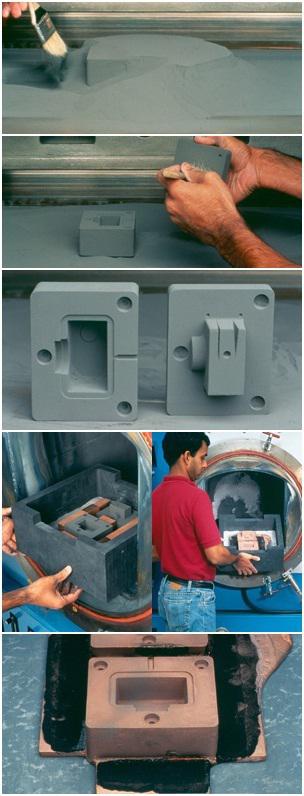
One drawback is the lack of ILMS varied within wide limits the content of the refractory phase (base material). Since its percentage content in the final product is determined by the bulk density of the powder, which according to the characteristics of powder can be three or more times smaller than the theoretical density of the material powder.
Materials and their properties used for ILMS i>

The direct metal laser sintering (DLMS) h4>
The direct metal laser sintering similar ILMS, but differs in that instead of the polymer used alloys or compounds with a low melting point, and there is no such a process step as impregnation. The basis of the concept of creating DMLS was a German company EOS GmbH, which in 1995 established a commercial plant for direct laser sintering powder of steel-nickel bronze. Preparation of various products using DLMS is based on the resulting melt-wicking ligament in the voids between the particles by capillary action. In addition, for successful execution of the process to the powder mixture was added with phosphorus compounds, which reduce the surface tension, viscosity and degree of oxidation of the melt, thereby improving wettability. Powder used as a binder generally has a smaller size than the base powder, as it allows to increase the bulk density of the powder mixture and to accelerate the formation of the melt.
Materials and their properties used for DLMS by EOS GmbH i>

Selective laser melting (SLM) h4>
Further improvement of the facilities for additive manufacturing is associated with the advent of the possibility of using a more powerful laser, the smaller diameter of the focusing spot and applying a thin layer of powder, which allowed the use of SLM for the manufacture of various metals and alloys. Usually the product obtained by this method have a porosity of 0-3%.
As in the above discussed methods (ILMS, DMLS), a major role in the process of manufacturing products plays wettability, surface tension and viscosity of the melt. One of the factors limiting the use of various metals and alloys for the SLM is the effect of "balling" or spheroidization, which manifests itself as the formation lying separately droplets rather than solid track melt. The reason for this is under the influence of surface tension, which tends to decrease the melt free surface energy by forming a shape with a minimum surface area, i.e. world. In the melt strip Marangoni effect is observed, which is manifested in the form of convective currents due to gradient of surface tension as a function of temperature, and if the convective currents are strong enough, then the melt strip is divided into individual drops. Also, a drop of the melt under the influence of surface tension pulls a nearby powder particles, which leads to the formation of holes around the droplets and, ultimately, to increase the porosity.
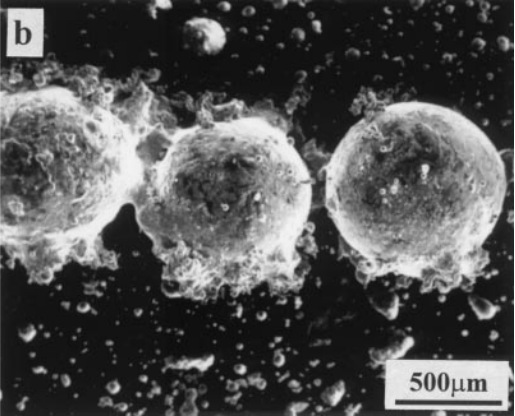
Spheroidizing steel M3 / 2 at suboptimal conditions SLM i>
Spheroidizing effect also contributes to the presence of oxygen which is dissolved in the metal melt viscosity increases, leading to deterioration of the wettability and spreading of the molten layer lying below. According to the above listed reasons can not obtain products from metals such as tin, copper, zinc, lead.
It is worth noting that the formation of high-quality strip melt associated with finding the optimum field of process parameters (laser power and scanning speed), which is usually quite narrow.
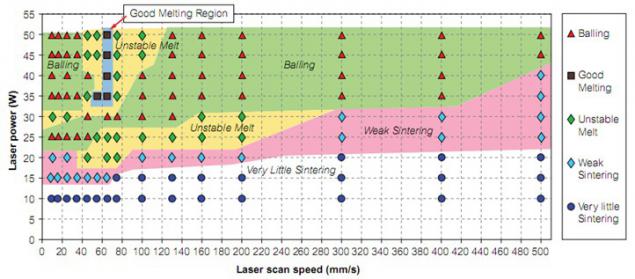
The influence of parameters on the quality of the gold SLM formed layers i>
Another factor affecting product quality is the appearance of internal stresses, presence and amount of which depends on the geometry of the product, heating and cooling rates, thermal expansion coefficient, and phase changes in the metal structure. Significant internal stresses can lead to deformation of the product, the formation of micro- and macro-cracks.
Partially reduce the negative impact of the above mentioned factors can be achieved by the use of heating elements, which are typically located inside the device around the substrate or the powder feeder. Heating the powder also allows to remove adsorbed moisture from the surface of the particles and thereby reduce the extent of oxidation.
When selective laser melting of metals such as aluminum, copper, gold is not unimportant question is their highly reflective, which necessitates the use of high-power laser systems. But the increasing power of the laser beam can adversely affect the dimensional accuracy of the product, since the excessive heating of the powder will melt and sinter outside the laser spot due to heat transfer. High power laser can also lead to a change in the chemical composition due to evaporation of the metal, which is especially characteristic for alloys containing fusible components and having a vapor pressure greater.
The mechanical properties of the materials obtained by the SLM (company EOS GmbH) i>
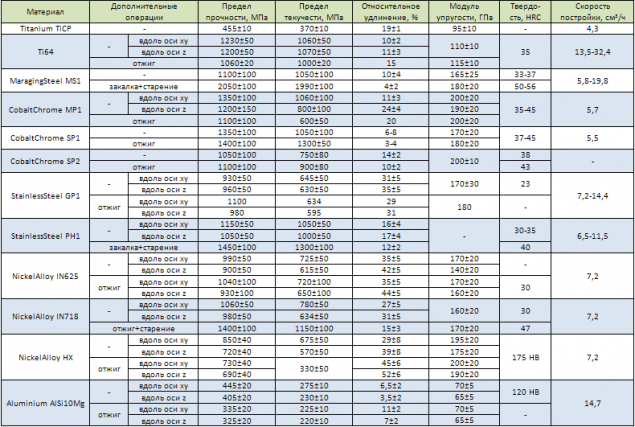
If the product is received by one of the methods discussed above, has a residual porosity, then if necessary apply additional processing steps to increase its density. For this purpose, the methods of powder metallurgy - sintering or hot isostatic pressing (HIP). Sintering eliminates the residual porosity and improve the mechanical properties of the material. It should be emphasized that the properties of the material formed in the sintering process by the composition and nature of the material, size and number of pores, the presence of defects and numerous other factors. HIP is a process in which the preform is placed in gazostat compacted under the action of heat and uniform compression inert gas. Operating pressure and the maximum temperature reached gazostat depends on its design and volume. For example, gazostat having dimensions of the working chamber 900h1800 mm, able to develop a temperature of 1500 o sup> C and a pressure of 200 MPa. Using the GUI to eliminate porosity without the use of containment is possible if the porosity is not more than 8%, because the high value of the gas through its pores will fall inside the product, thus preventing the seal. Delete the entry into the product gas is possible by manufacturing the steel containment surface follows the shape of the product. However, the products obtained additive manufacturing, generally have a complex shape, which makes it impossible to manufacture such a sheath. In that case you can use to seal the evacuated sealed container in which the product is placed in a granular medium (Al 2 sub> O 3 sub>, BN hex sub>, graphite) transmitting the pressure on the walls of the product.
After the additive manufacturing method SLM materials characterized anisotropy properties, high strength and low ductility due to the presence of residual stresses. For stress relief, more equilibrium structure, increasing the viscosity and plasticity of the material to anneal.
According to the data given below, one can note that the products produced by selective laser melting, in some cases stronger than cast 2-12%. This can be attributed to the small grain size and microstructural constituents that are formed by rapidly cooling the melt. Fast melt supercooling considerably increases the number of nuclei of the solid phase and reduces their critical size. In this fast-growing on the seed crystal in contact with each other, start to impede their further growth, thereby forming a fine grain structure. Nucleating agents are typically non-metallic inclusions or gas bubbles are released from the particles melt at their limited solubility in the liquid phase. In general, according to the Hall-Petch relation, with decreasing grain size increases the strength of the metal from the extensive network of grain boundaries, which is an effective barrier to movement of dislocations. It should be noted that due to different chemical composition of the alloys and their properties, the conditions of the SLM, the above-mentioned phenomena which occur during cooling of the melt, appear with varying intensity.
The mechanical properties of the materials obtained SLM and cast i>

Of course, this does not mean that the product obtained by selective laser melting of the best products obtained by conventional methods. Thanks to the great flexibility of the traditional ways of getting products can be widely varied properties of the product.















